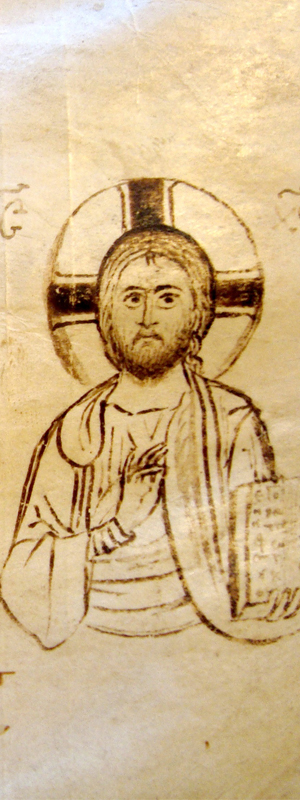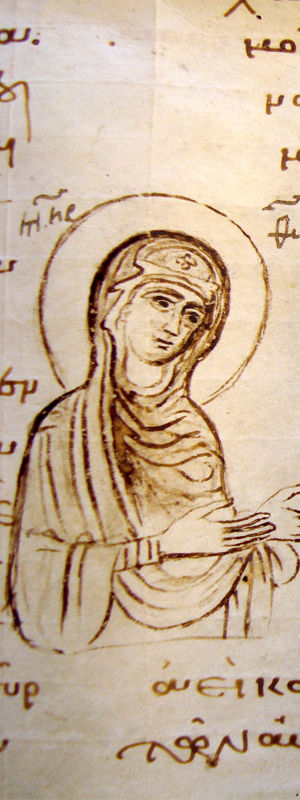Abulafia, The Great Sea. A Human History of the Mediterranean, Londres, 2013 (Trad. Esp. El Gran Mar. Una historia humana del Mediterráneo, Barcelona, 2013).
Alay Rodríguez, J.C., Clariana i Roig, J.F., “El capitell bizantí de Santa Maria de Mataró (Maresme) i la IV Croada”, en Els Monestirs Medievals, Actes de les IV Jornades d’Història i Arqueologia Medieval del Maresme, Mataró 2011, pp. 61-63.
Ayensa, Els catalans a Grècia. Castells i torres a la terra dels Déus, Barcelona 2015 (con extensa bibliografía).
Androudis, A. Yangaki, “A fragment of the Pula Type of lustreware immured at the exonarthex of the Katholikon of the monastery of the Hilandari (Mount Athos Peninsula), Matica srpska journal for Fine Arts, 42 (2014), pp. 51-60.
Barsanti, M. Pilutti Namer, “Da Constantinopoli a Venezia: nuove spoglie della chiesa di S. Polieucto”, Nea Rhome, 6, 2009, pp. 133-156.
Burns, “The Catalan Company and the European Powers, 1305-1311”, Speculum, 1954, 751-771.
Bacci, M. Rohde, The Holy Portolano/ Le portulan sacré. The Sacred Geography of Navigation in the Middle Ages. Fribourg Colloquium 2013, Berlin: De Gruyter, 2014.
Bacci, ‘Byzantium and the West’, in: R. Cormack and M. Vassilaki (eds.), Byzantium 330-1453, exhibition catalogue (London, Royal Academy of Arts, 25 October 2008-22 March 2009), London, Royal Academy of Arts, 2008, pp. 275-279 and 464-465.
Bacci, ‘Greek Painters Working for Latin and Non-Orthodox Patrons in the Late Medieval Mediterranean’, in: J. Anderson (ed.), Crossing cultures: conflict, migration and convergence: the proceedings of the 32nd International Congress of the History of Art, Melbourne, Melbourne University Publishing, 2009, pp. 196-201.
Bacci, ‘La moltiplicazione dei luoghi sacri lungo le vie d’acqua per Gerusalemme nel tardo Medioevo’, in P. Caucci von Saucken and R. Vázquez (eds.), Peregrino, ruta y meta en las peregrinationes maiores. VIII Congreso internacional de estudios jacobeos (Santiago de Compostela, 13-15 Octubre 2010), Santiago de Compostela: Xunta de Galicia 2012, pp. 179-194.
Bacci, ‘Toscane, Byzance et Levant: pour une histoire dynamique des rapports artistiques méditerranéens aux XIIe et XIIIe siècles’, in J.-P. Caillet and F. Joubert (eds.), Orient et Occident méditerranéens au XIIIe siècle. Les programmes picturaux, Paris: Picard 2012, pp. 235-256.
Bacci, ‘Some Thoughts on Greco-Venetian Artistic Interactions in the Fourteenth and Early Fifteenth Centuries’, in Antony Eastmond and Liz James (eds.), Wonderful Things: Byzantium through Its Art, Farnham: Ashgate, 2013, pp. 203-227.
Bacci, ‘Veneto-Byzantine “Hybrids”: Towards a Reassessment’, Studies in Iconography 35 (2014), pp. 73-106.
Bacci, C. Jäggi, Bi. Kühnel, R. Quirini-Popławski, A. Shalem, G. Wolf, ‘Qu’est-ce que l’espace méditerranéen au Moyen Âge’, Perspective (2014), n. 2, p. 271-292.
Bay – L. Carletti – F. Paliaga (eds.), Storia illustrata della pittura a Pisa dalle origini al Cinquecento, Pisa (Pacini editore) 2015.
Baydal Sala, “Santa Tecla, San Jorge y Santa Bárbara: los monarcas de la Corona de Aragón a la búsqueda de reliquias en Oriente (siglos XIV-XV)”, Anaquel de Estudios Árabes, 21, 2010, 153-162.J-P, Caillet and F. Joubert, Orient et Occident méditerranées au XIIIè. Les programmes picturaux (Paris 2012).
Bon, “Forteresses médiévales de la Grèce centrale”, Bulletin de Correspondance hellénique, 61 (1937), pp. 136-208.
Burresi – L. Carletti – C. Giometti (eds.), I pittori dell’oro. Alla scoperta della pittura a Pisa nel Medioevo, Pisa 2002
M. Burresi, A. Caleca, Cimabue a Pisa. La pittura pisana del Duecento da Giunta a Giotto. Catalogo della mostra (Pisa, 25 marzo 2005-25 giugno 2005).
Castiñeiras, “Oxford, Magdalen College, ms. Gr. 3: Artistic Practice, Byzatine Drawings and Mobility in Medieval Mediterranean Painging around 1200”, Arte Medievale, Nuova Serie, IV, 2015.
Castiñeiras,”Catalan Panel Painting around 1200, the Eastern Mediterranean and Byzantium”, in Romanesque Art and the Mediterranean, R. Bacile, J. McNeill (dir.), Maney, Leeds, 2015.
Castiñeiras, “La peinture autour de 1200 et la Méditerranée: voies d’échanges et processus de transformation entre Orient et Occident”, Les Cahiers de Saint-Michel de Cuxa, XLVII, 2016 (en prensa).
Castiñeiras, “Weaving stories, images and devotions: the Medieval Mediterranean as a backdrop”, in A Sea and Its Saints: Hagiography and the Structurin of the Mediterranean in the Middle Ages, N. Jaspert, M. di Branco (dir.), Roma, 2016 (en prensa).
Constantoudaki-Kitromilidis, “Viaggi di pittori tra Costantinopoli e Candia: documenti d’archivio e influssi sull’arte (XIX-XV sec.)”, ed. Chr. Maltezou, A. Tzavara, D. Vlassi, I Greci durante la Venetocrazia: uomini, spazio, idee (XIII-XVIII sec.), Venezia 2009, pp. 709-723.
Cultural Brokers at Medieval Courts in the Middle Ages ( N. Jaspert, 2013).
Davis, D. Howard, W. Pullan, Architecture and Pilgrimage, 1000-1500. Southern Europe and Beyond, Farnham, Surrey, UK, 2013.
de Dalmases, A. José i Pitarch, L’época del Císter, Segle XIII, Barcelona, 1985.
Duran i Duelt, “Icons and minors arts: a neglected aspect of trade between Romania and the crown of Aragon”, Byzantinische Zeitschrift, 105 (2012), pp. 29-52.
Duran i Duelt,”La Corona de Aragón y el Sinaí en la Edad Media. A propósito del retablo de Santa Catalina de Bernat de Maresa, cónsul catalán en Damasco”, Erytheia, 32 (2011), pp. 217-244.
Durand, D. Giovannoni, eds, Chypre entre Byzance et l’Occident, IVè-XVIè siècle (Paris 2012).
Efthymiadis, A. Mazarkis, “Questions de chronologie sur Ramon Muntaner et Georges Pachyméres. La Prise de Phocée et the Thasos en 1307”, Greek, Roman and Byzantine Studies 49 (2009), pp. 303-321.
Geymonat, “Drawing, Memory and Imagination in the Wolfenbüttel Musterbuch,” in Mechanisms of Exchange:Transmission in Medieval Art and Architecture of the Mediterranean, ca. 1000-1500, eds. Heather E. Grossman and Alicia Walker, Medieval Encounters, 18 (2012), 518-82
Georges Pachymérès. Relation Historiques. III. Livres VII-IX; X-XIII, ed. Failler, París, 1990.
Folda, Crusader Art in Holy Land, from the Third Crusade to the Fall of Acre, 1187-1291 (Cambridge 2005), 511-25.
Fuguet, L’arquitectura dels Templers a Catalunya, Barcelona, 1995.
J. Geary, Le vol des reliques au Moyen Âge, París, 1993.
Guardia Pons, M. , «L’Escultura monumental i decorativa», Del romà al romànic. Història, Art i Cultura de la Tarraconense mediterrània entre els segles VI i X, Enciclopèdia Catalana, Barcelona, 1999, pp.205-248.
M. Harrison, “The Church of St. Polyeuktos in Istanbul and the Temple of Salomon”, Okeanos. Harvard Ukraninan Studies, Essays presented to Ihor Sevcenko in his Sixtieth Birthday by his Colleagues and Students, ed. C. Mango, O. Pritsak, Harvard, 1984, 276-279.
Homs i Guzman, “Relats de Pelegrinatge a Terra en llengua catalana. Un camí de set segles”, Analecta Sacra Tarraconensia, 76, 2003, 5-43.
Howard, Venice & the Past. The Impact of the Islamic World on Venetian Architecture 1100-1500, New Hawen-Londres, 2000.
Kühnel, Crusader Art of the Twelfth Century. A Geographical and Historical or an Art Historical Notion? (Berlin 1994).
Jaspert, “Gefangenloskauf in der Krone Aragón und die Anfänge des Mercedarierordens”, Gefangenenloskauf im Mittelmeerraum, ed. H. Grieser, N. Priesching, Hildesheim, 2015, 99-121.
E. Laiou, Constantinople and the Latins. The Foreign Policy of Andronicus II, 1282-1328, Cambridge, Mass, 1972.
Latins and Greeks in the Eastern Mediterranean after 1204, By B. Arbel, B. Hamilton, D. Jacoby, New York, 1989.
Liaño et al. Tarragona y Lérida, Madrid, 1987.
Lutrell, Latin Greece, The Hospitallers and the Crusades 1291-1440, London, 1982.
The Catalan Atlas of the year 1375, ed. G. Grosjean, Zurich, 1978.
L’esplendor de la Mediterrània medieval (segles XIII-XV), ed. X. Barral i Altet, Barcelona, 2004.
Mango, C., Sevcencko, I., “Remains of the Church of St. Polyeuktos at Constantinople”, Dumbarton Oaks Papers, 15, 1961, 243-247.
Maguire, H, Nelson, R.S. (eds.), Byzantium and the Myths of Venice, Dumbarton Oaks Research Library and Collection, Washington DC, 2010
Mitteraurer, J. Morrissey, Pisa nel Medioevo. Potenza sull mare e motore di cultura, Roma, 2015.
Molin, Unknown Crusaders Castles, New York, 2001.
Molina, “Sotto il segno d’Oriente. La monarchia catalano-aragonese e la ricerca del sacor nelle terre el Levante Mediterraneo”, Representation of Power at the Mediterranean Borders of Europe (12th-14th centuries), ed. I. Baumgärtner, M. Vagnoni, M. Welton, Florencia, 2014, p. 71-90).
Niglio, Akko, perla del Mediterraneo, Pisa, 2009.
Pringle, Pilgrimages to Jerusalem and the Holy Land, 1187-1291, Farnham, Surrey, UK, 2012.
Rubió i Lluch, Diplomatari de l’Orient Català (1301-1409), Barcelona, 2001.
Semoglou, Thècle à l’aube du Christianisme, Tesalónica, 2014.
M. Setton, Catalan Domination of Athens, 1311-1388, Cambridges, Mass., 1948.
San Marco, Byzantium and the Myths of Venice, H. Maguire, R. S. Nelson, Washington, 2010.
M. Setton, Catalan Domination of Athens, 1311-1388, Cambridge, Mass., 1948.
F Soldevilla, Les quatre grans Cròniques. Crónica de Ramon Muntaner, Barcelona, 2011.
T. Ferrer i Mayol, ed., Els Catalans a la Mediterrània oriental a l’edat mitjana, Jornades Científiques de l’Institut d’Estudis Catalans, Secció Històrico-arqueològica, Barcelona, 2003.
T. Ferrer i Mayol, D. Coulon, eds., L’Expansió catalana a la Mediterrània a la Baixa Edat Mitjana, Actes del Séminaire/Seminari organitzat per la Casa de Velázquez (Madrid) i la Institució Milà i Fontanals (CSIC, Barcelona), Barcelona, 1999
The Byzantine Contribution to the Western Art of the 12th and 13thcenturies, número monográfico de Dumbarton Oaks Papers, 20 (1966), coordinado por K. Weitzman y E. Kitzinger.
The Year 1200: A Centennial Exhibition at the Metropolitan Museum of Art, ed K. Hoffmann (New York 1970), 2 vols; The Year 1200: A Symposium, The Metropolitan Museum of Art (New York, 1975).
Vielliard, “Pèlerins d’Espagne à la fin du Moyen Âge”, Analecta Sacra Tarraconensia, 12, 1936, 265-300.
Western Travellers to Constantinople. The West and Byzantium, 962-1204. Cultural and Political Relations, K. N. Ciggar (1996).


